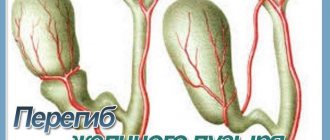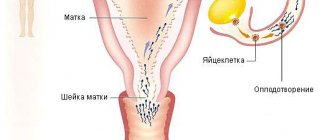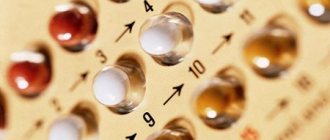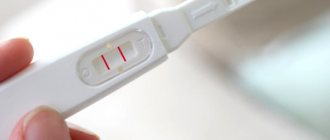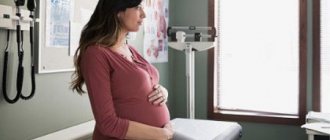Pregnancy without a gallbladder is not an obstacle to bearing a fetus.
The absence of an organ does not in any way affect the course of pregnancy or the success of childbirth. The absence of a gallbladder also does not affect the health of the newborn. However, some women note the consequences of a removed organ in their condition. Thus, some pregnant women report that they experience more severe gestosis (a complication of normal pregnancy). However, there are no clinically documented cases of pregnancy loss or serious deterioration in maternal health. In order for the pregnancy to proceed without complications, the mother should follow the doctor’s instructions: maintain the prescribed diet, limit physical activity, and avoid stress and anxiety.
Is it possible to carry a child to term after gallbladder removal?
Bile has no effect on the reproductive system. Therefore, there are no obstacles to pregnancy. However, it is important to wait between the operation and conception. A cholecystectomy involves making incisions or punctures in the abdominal cavity. Stretching of tissues during pregnancy can lead to sutures coming apart. In addition, the body needs time to adapt to new conditions. Carrying a child will complicate the process.
The period after which doctors recommend conceiving a child depends on the complexity of the surgical intervention performed, the quality of rehabilitation and the general condition of the woman’s body.
Pregnancy without a gallbladder requires increased attention from doctors. The woman is observed not only by a gynecologist, but also by a gastroenterologist. It is important to prevent complications or deterioration of the general condition of the pregnant woman.
To do this, the expectant mother must adhere to some rules:
- Monitor your diet, avoiding long breaks between meals. The optimal is 5-6 meals a day in small portions.
- Food should be boiled, baked or steamed.
- It is important to completely exclude fatty, fried, salted, smoked, spicy, marinades and spices from the diet.
- Drinking alcohol is prohibited.
- After cholecystitis or cholecystectomy surgery, a pregnant woman should take choleretic drugs. They prevent seizures during pregnancy. The stretching uterus puts pressure on the ducts that have taken over the functions of the gallbladder. It is important to liquefy the liver secretion so that it can flow through the narrowed lumens.
- It is recommended to carry out tubing periodically. To do this, drink warm mineral water or sorbitol solution on an empty stomach. Afterwards you need to lie on your right side, placing a heating pad under it. It is recommended to remain in this position for several hours.
By following these simple recommendations, a woman can get pregnant without any problems and carry a healthy baby.
Changes in the body after gallbladder removal
Any operation to remove the gallbladder is accompanied by digestive disorders: absorption and digestion of food. Most patients do not even notice these disorders, so changes at the systemic level are not significant.
During pregnancy, the load on a woman’s body increases several tens of times, so women with a removed gallbladder may experience some difficulties in bearing a child. These include:
- Severe dyspeptic disorders: severe nausea, vomiting. Flatulence and bloating, loose loose stools or constipation. Some women experience a bitter taste in their mouth.
- Pain in the epigastrium and right hypochondrium of an aching nature, intensifying after eating fatty or spicy foods. Sometimes the pain radiates to the back or lower back.
- Longer duration of early toxicosis in pregnant women.
- Difficulties associated with diet and food restrictions.
Multiple pregnancy after cholecystectomy
During multiple pregnancy, the load on a woman’s body increases.
Pathologies of the biliary system, for example, cholecystitis, often become a kind of payment for carrying twins and triplets at the same time. They stretch the uterus more. Stagnation of bile in a cramped, upwardly displaced bladder cannot be prevented. The result is infection of the liver secretion with subsequent inflammation of the bile walls. But how does the body react when it has already lost its bladder due to such problems? The uterus presses on the remaining bile ducts. They not only get pinched, but also contract with difficulty. The latter is associated with the active production of the hormone progesterone. It has a relaxing effect on smooth muscles. This is a natural defense mechanism against premature birth. They can be caused by muscle spasms.
An additional safety net is taking magnesium prescribed by your gynecologist. It also relaxes smooth muscles. This helps keep the fruit safe.
For the biliary system, changes are fraught with:
- Long-term stagnation of bile in the ducts.
- The thickening of a stagnant secret.
- Precipitation from the bile in the form of crystals of calcium salts, cholesterol, bilirubin pigment, followed by gluing of the particles into stones.
- Inflammation of the bile ducts as a result of infection of thickened bile. When stagnation occurs, it becomes a concentration of toxins, an excellent breeding ground for bacteria.
The question is not how long you can become pregnant after removal of the gallbladder, but how to carry it to term.
Considering the risks, relaxation in diet and overeating are unacceptable. This will not only lead to increased production of bile by the liver and congestion, but also to active growth of fruits. The older the children, the more pressure they put on the digestive tract. If a woman has had her gallbladder (GB) removed, planning a pregnancy and carrying it to term must be especially careful. It is worth preparing for toxicosis. For those who have undergone cholecystectomy, this is the norm. During multiple pregnancies, toxicosis is often severe and lasts longer than standard, up to 16 weeks.
Due to toxicosis, some patients operated on during the first 3-4 months of gestation are forced to undergo conservation. Pregnant women become weaker, cannot eat, and receive a nutritious “cocktail” through an IV.
Changes in the functioning of the biliary system during pregnancy
During pregnancy, a patient with cholelithiasis must monitor her diet, which reduces the risk of complications. However, unpleasant symptoms cannot be ruled out:
- severe attacks of nausea and vomiting;
- pain in the right hypochondrium;
- constipation or diarrhea;
- yellowing of the skin and mucous membranes.
This happens because the growing fetus increases the size of the uterus. It puts pressure on the abdominal organs, which creates additional stress on the biliary system. You need to make sure that no stones have formed in the bile ducts, that bile flows normally, and that there is no stagnation. This can be done through ultrasound.
As for the liver, after successful removal of the gallbladder, it works as usual. In some women, especially in the last stages of pregnancy, the number of liver enzymes increases. They are prescribed choleretic drugs that normalize the flow of bile.
How does pregnancy proceed after cholecystectomy?
Cholecystectomy is considered a safe operation. In 50% of women undergoing surgery, the operation does not cause significant changes in the functioning of the body. But it is still recommended to plan a pregnancy after removal of the gallbladder approximately 12 months after surgery. The rehabilitation period takes so long.
When carrying a child after removal of the gallbladder, you need to be prepared:
- to frequent digestive disorders and stool disorders (constipation or diarrhea);
- increased gas formation and bloating;
- phantom pain in the area of the removed organ.
The last symptom refers to postcholecystectomy syndrome. It is associated with a violation of the discharge of bile and its stagnation. This is likely in late pregnancy due to the pressure of the grown fetus on the liver. The bile anatomically partially enters it. Therefore, when the liver hurts, it seems that the bladder hurts, even though it is no longer there.
In addition to pain on the right under the ribs with postcholecystectomy syndrome during pregnancy, a woman is worried about:
- heartburn or bitter taste in the mouth;
- feeling of heaviness in the stomach;
- Itching sensation in the palms or soles, especially at night.
The listed symptoms are characteristic of exacerbation of cholecystitis. For postcholecystectomy syndrome, typical sensations are experienced before surgery to remove the bile duct. In other words, it seems that the disease has returned.
In pregnant women, the syndrome is often short-lived and mild in nature.
To protect themselves from the unpleasant sensations associated with the absence of a gallbladder, women should engage in prevention:
- Eat often, but in minimal portions of about 200 grams.
- Stick to a healthy diet. “Table No. 5” is recommended.
- For preventive purposes, take choleretic drugs approved for pregnant women. With your doctor's permission, you can use traditional herbal recipes.
- Do light gymnastics. A set of exercises will be recommended by a gastroenterologist.
- Perform tubing periodically.
The expectant mother should pay special attention to the quality of nutrition. It should be as useful and balanced as possible. Fatty and fried, spicy, smoked and spicy foods should be completely excluded from the menu. The diet should be based on fermented milk products, proteins and healthy carbohydrates (fruits, vegetables). Food should be prepared by baking, boiling or steaming.
In general, doctors note that bearing a child of a healthy woman and one whose gallbladder has been removed, from a physiological point of view, is no different. The only difference is increased control over the course of pregnancy not only by a gynecologist, but also by a gastroenterologist.
If the organ was removed by laparotomy, the woman must undergo an ultrasound to check the condition of the scar. This is especially true in the second half of pregnancy, when the fetus has already grown enough and begins to put pressure on the surrounding tissues.
Pregnancy without a gallbladder
The waiting period for a baby is closely related to the risk of unpleasant health consequences. Hormonal transformation affects all concepts of the body. This especially applies to digestion, which is interconnected with the production and excretion of bile.
The body digests food, breaks down fats, carbohydrates and nutrients. After gall bladder surgery, it will take several weeks or 2-3 months before the bile duct increases in volume to its limit. Bile accumulates and steadily enters the intestinal tract. The loss of an organ is compensated through this process.
Sometimes, a repeated attack of pain ends only in the surgical department. Surgery - cholecystectomy is common among females, as is surgery to remove appendicitis. It is usually performed by opening the abdominal wall or laparoscopically.
The pregnant woman, after elimination, remains under the continuous supervision of a gynecologist and gastroenterologist. In order not to miss a shift for the worse, you must adhere to strict guidelines.
Pregnancy without a gallbladder has no effect on your general condition. Expectant mothers should definitely monitor the correct diet. Do not make long pauses between techniques. It is preferable to eat food no more than 5-6 times a day.
Since the beginning of fruiting, a strong heaviness in the right hypochondrium has been bothering me. The pain moves, radiates to the shoulder blade, under the left rib, shoulder. Other symptoms:
- increased gas formation;
- stool dysfunction;
- heartburn, rumbling;
- nausea, bitter taste.
The physiological disorder will not affect pregnancy, the woman will be able to carry a child. The hepatobiliary system stabilizes 1.5–2 years from the date of removal. During the first 6 months, stagnation is repeated, and a feeling of discomfort arises.
It is necessary to control any modifications and carefully monitor nutrition. Then, strong children will be born, even after medical intervention.
How long after surgery can you get pregnant?
Removing the gallbladder does not mean that the body can no longer cope with fatty foods.
After some time (from 1 month to 1 year), this process is almost completely restored. After rehabilitation, the bile ducts expand as much as possible and begin to accumulate secretions produced by the liver, like a bladder. The concentration of bile in the channels now prevents its continuous flow into the intestines. The digestion process is improving. Therefore, pregnancy after cholecystectomy is practically no different from normal. But to avoid complications, it is important to undergo a full course of rehabilitation after the operation.
Your doctor will tell you exactly when you can get pregnant after gallbladder removal. It is necessary to conduct a comprehensive examination, determine the general condition and the presence of concomitant pathologies.
If the organ is removed by laparoscopy, the body is often ready for conception within a few months. After laparotomy, the period is extended to a year. As a rule, this period is sufficient to form a scar and restore the functioning of the gastrointestinal tract. However, doctors advise waiting about 6 more months. This will reduce risks to a minimum.
If pregnancy occurs almost immediately after surgery, the recovery period may be more difficult. There is a high probability of digestive disorders. The consequence is a deterioration in the woman’s general condition, insufficient absorption of vitamins and other nutrients.
In addition there are:
- risk of spontaneous abortion in the early stages;
- the occurrence of early toxicosis;
- risk of premature birth;
- the occurrence of jaundice in a newborn.
If you endure the necessary rehabilitation period, such violations practically do not occur. To speed up recovery time, it is recommended to regularly engage in therapeutic exercises. Performing physical exercises helps improve the discharge of bile and prevent the formation of stones.
Cholecystectomy and pregnancy
Pregnancy is a wonderful time for a woman, when all her thoughts are occupied with waiting for the baby to be born. From the first days of gestation, you need to take care of the health of the unborn child, but you should not forget your health.
The incidence of cholecystitis is steadily increasing every year more and more, especially among the fair sex. In most cases, doctors are forced to undergo surgery to remove the gallbladder (cholecystectomy). However, is it possible to get pregnant after cholecystectomy, and is pregnancy compatible with diseases of the biliary tract?
How do women without gall bladder experience childbirth?
The absence of a gallbladder in a woman is not an indication for a cesarean section. If there are no gynecological or other pathologies that prevent natural childbirth, they give birth on their own.
Caesarean section becomes mandatory when:
- thinning;
- immaturity;
- failure of the postoperative scar.
If the condition of the scar left after removal of the gallbladder is satisfactory, there is no risk of complications during childbirth.
In conclusion, we can say that cholecystectomy does not have a negative impact on the process of fertilization or the development of the baby. Sometimes, a pregnant woman may experience some complications associated with removal of the gallbladder. However, with proper rehabilitation and medical supervision, a woman has every chance of successfully becoming pregnant, carrying and giving birth to a healthy baby.
Pregnancy after laparoscopic gallbladder removal
Postoperative complications after laparoscopic surgery are observed in exceptional cases, and the recovery period lasts a couple of weeks. Theoretically, conceiving a child and planning pregnancy is possible immediately after discharge from the hospital. However, it must be remembered that in the early postoperative period the body adapts to new conditions: changes in the rheology of pancreatic and bile secretions, decreased motility of the stomach and intestines. If pregnancy occurs during this period of time, it is quite difficult to tolerate.
To avoid this, it is recommended to use contraceptives for the first 4 weeks. As soon as the condition stabilizes and the body and gastrointestinal tract adapts, you can plan a pregnancy.
The course of such a pregnancy is no different from a normal physiological one. Women are advised to follow a diet limiting fatty, spicy and other irritating foods, but do not overdo it. The body needs additional proteins and carbohydrates. The diet is designed in such a way that it is high in calories and varied.
Important! Even during pregnancy, women who have had gallbladder removal surgery are advised to follow a healthy diet and eating habits. The emphasis is on protein foods - meat, milk and dairy products, fish, vegetables and fruits, cereals. It is better to cook food by steaming or boiling. Consumption of fried foods and additives in the form of spices and spices is kept to a minimum.
How to avoid complications
To prevent the occurrence of pain during pregnancy in the absence of a gallbladder in women, there is no need to follow strict rules and adhere to strict restrictions. It is enough just to eat regularly, without long breaks, and not to consume prohibited foods, especially fatty, fried and spicy foods. Smoked foods are also prohibited.
Focus on your feelings. Usually women know which foods cause pain and nausea, so during pregnancy with the gallbladder removed you definitely shouldn’t eat them.
Remember that a woman’s diet has a huge impact on a child’s development. Some expectant mothers are afraid of exacerbation of pain and eat monotonously, which is absolutely forbidden to do. Eat a little bit, but different foods, be sure to eat vegetables, fruits, non-acidic berries, greens. The meat should be lean. Be sure to include cottage cheese in your diet.
From the first days of pregnancy, take multivitamin complexes with folic acid. They are prescribed by a gynecologist, but they are usually contacted for the first time when registering - 1.5-2 months after conception. And the formation of the fetal neural tube occurs just in the first months, and a deficiency of folic acid and other useful substances should not be allowed. As soon as you find out you are pregnant, immediately start taking standard vitamin and mineral complexes for pregnant women.
In this video, experts talk about the rules of nutrition after cholecystectomy, which will be useful for women during pregnancy who have previously had their gallbladder removed.
Expectant mothers who have encountered pathologies of the biliary tract may wonder: is it possible to get pregnant after removal of the pyriform organ?
This article will discuss whether it is possible to conceive a child with this disease, what risks exist if the gallbladder is removed, and also about when you can get pregnant after laparoscopy.
Chronic cholecystitis before childbirth
This pathology is characterized by the development of an inflammatory process in the walls of the gallbladder.
The main factors provoking this pathology are infectious infection and the occurrence of bile stagnation, which is most often caused by impaired motility of the organ itself and its ducts (dyskinesia).
Dyskinesia is of two types: hypermotor (increased tone of the muscle walls above normal) and hypomotor (deterioration in the contractility of these walls). During pregnancy, hypomotor disorders occur, as a result of which the outflow of bile worsens and stagnation occurs.
This is explained by the fact that during the second half of pregnancy, a woman’s level of a hormone called progesterone significantly increases, which has a relaxing effect not only on the uterus, but also on all the smooth muscles of other internal organs. The relaxed muscles of the bladder and its ducts are no longer able to effectively empty the cavity of the bile reservoir, and the burn begins to stagnate. It is for this reason that chronic cholecystitis mainly occurs in pregnant women.
This pathology manifests itself with the following symptoms:
- pain in the right hypochondrium, which can spread to the right shoulder, right shoulder blade and even to the left side of the abdomen;
- bitter taste in the mouth;
- air belching;
- nausea, which often turns into vomiting that does not bring relief.
It has been noticed that approximately 25 percent of women associate the appearance of pain in the right side of the abdomen with the movements of the fetus or its location inside the uterus, and do not attach much importance to this, which makes it difficult to diagnose this pathology.
The main diagnostic technique for detecting chronic cholecystitis (as well as other pathologies of the gallbladder) is currently ultrasound of the abdominal organs.
The pictures are taken on an empty stomach, then the patient is given a choleretic breakfast, after which the pictures are repeated. The difference in the size of the bladder allows the specialist to identify the signs and type of dyskinesia. During pregnancy, the course of chronic cholecystitis quite often worsens, exacerbations occur (in about half of the patients), and this usually happens in the third trimester of pregnancy.
Read also: Basics of preventing gallstones
In turn, the chronic form of this disease also affects the course of pregnancy. This disease can provoke early toxicosis, and it can last twenty, and in some cases, up to twenty-eight weeks.
Treatment of chronic cholecystitis for pregnant women is no different from the treatment of this pathology in all other patients.
Gallbladder removal
First of all, it is necessary to follow a diet called “Healing Table No. 5”, the principles and diet of which will be explained by a gastroenterologist. As for drug therapy, it consists of taking choleretic drugs. Since hypomotor dyskinesias predominate in pregnant women, cholekinetics are used as such drugs, improving the contractile function of the organ and its ducts.
Among such drugs, experts primarily highlight xylitol and sorbitol (in the form of a 10-15 percent solution), which should be taken in doses of 50 to 70 milliliters half an hour before meals, two to three times a day.
Doctors often prescribe decoctions of medicinal herbs and herbs. The simplest way to prepare them is to brew them at the rate of one tablespoon of crushed plants per glass of boiling water. Immortelle flowers, dried mint leaves, corn silk, dill seeds, barberry roots, rose hips, and so on can be used as such folk remedies. After infusing the brewed mixture for half an hour, the broth should be cooled and strained. Dosage regimen: warm, take a third of a glass three times a day before meals (half an hour before).
In the second half of pregnancy, when there is a need to strictly control the amount of drink consumed, the most convenient remedy is flamin. To relieve particularly severe pain, a single dose of one antispasmodic tablet (for example, no-shpa) or baralgin is allowed.
It is worth saying that cholecystitis should be treated not only during its exacerbation, but also with preventive courses. This will ease the course of pregnancy and contribute to its successful completion.
Pregnancy after open gallbladder removal
Since this type of operation uses wide access to the abdominal cavity by dissecting all layers of the abdominal wall along the white line of the abdomen, the recovery period takes several months. Before planning a pregnancy, you need to wait until the suture is completely healed. When doctors diagnose the consistency of the formed scar (i.e. its strength), only then will the gynecologist allow you to plan a pregnancy. Until this time, the couple is recommended to use contraceptives.
Pregnancy proceeds without any special features. It is also recommended to follow a diet limiting fatty, fried and spicy foods. In the antenatal clinic, pregnant women are seen more often, especially in the last months, when the uterus reaches its largest size. Ultrasound monitoring of scar healing is carried out regularly. In addition, women are recommended to undergo examinations by a gastroenterologist at least once a trimester.
When can you plan a pregnancy?
Removal of the gallbladder is a simple, routine operation performed in hospitals of any level. Complications are extremely rare, and there are no global changes at the systemic level. The surgical intervention itself can be of 2 types:
- Laparoscopic removal of the gallbladder.
- Open upper midline laparotomy is a more traumatic method.
The course of pregnancy and the possibility of conceiving a child directly depend on the type of surgery performed.
During laparoscopy, 3-4 small incisions are made on the anterior abdominal wall. The recovery period takes only a couple of weeks, which means you can plan a pregnancy immediately after discharge from the hospital.
In an open laparotomy, an incision is made through the entire abdominal wall. The recovery period takes at least 3-4 months, in some cases up to six months. Only after this can a woman begin to plan a pregnancy.
Important! Removal of the gallbladder is not a contraindication to conceiving a child. A history of surgery has virtually no effect on the pregnancy and health of the unborn baby. However, before conceiving, it is better to consult a gastroenterologist or therapist at your place of residence.

